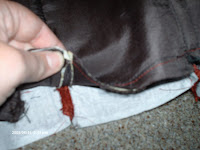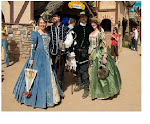I was going to work on the skirt, until I had a epiphany about how to sew the sleeves, so I went there. (Shrug)
 Looking at the inspiration picture of Elizabeth of Austria, there is quite a bit of slash and puff work on her sleeves. In general I'm not really a fan of doing slash and puff because they tend to look messy. To do it well, it requires a lot of hand work and a great deal of faith. The name is really backward- it should be slash and puff, since the former can't happen without the latter- something that has always annoyed me. :)
Looking at the inspiration picture of Elizabeth of Austria, there is quite a bit of slash and puff work on her sleeves. In general I'm not really a fan of doing slash and puff because they tend to look messy. To do it well, it requires a lot of hand work and a great deal of faith. The name is really backward- it should be slash and puff, since the former can't happen without the latter- something that has always annoyed me. :)I also tend to shy away from Puff and Slash because of the need for a chemise under your dress. Again, it causes extra bulk. Therefore I always try to mock puff and slash when I can. This will be an example of my mock style.
 Where did this style come from?
Where did this style come from?In short- the Germans. The Landsknechts, German mercenary soldiers who thrived from approximately 1487 - 1556, became known for their outlandish dress and effective fighting tactics. They were the finest fighting force in Europe. Their clothing was characterized by its "puff and slash" decoration, created by cutting slashes in the outer garments and pulling puffs of the under garments through those slashes.
 The "puff and slash" style of clothing was adopted by non-Germans too, becoming a standard mode of decoration in several parts of Europe. The English nobility was particularly enamored of puff and slash. Henry VIII started wearing it after seeing it on Landsknechts he had hired; in fact, the famous painting of Henry VIII by Hans Holbein depicts him in a doublet decorated with puff and slash. Other paintings of Henry depict him wearing what looks like a knee-length skirt; he adopted this style from German warskirts worn by some Landsknechts. Henry's children Edward VI and Elizabeth I also wore puff and slash.
The "puff and slash" style of clothing was adopted by non-Germans too, becoming a standard mode of decoration in several parts of Europe. The English nobility was particularly enamored of puff and slash. Henry VIII started wearing it after seeing it on Landsknechts he had hired; in fact, the famous painting of Henry VIII by Hans Holbein depicts him in a doublet decorated with puff and slash. Other paintings of Henry depict him wearing what looks like a knee-length skirt; he adopted this style from German warskirts worn by some Landsknechts. Henry's children Edward VI and Elizabeth I also wore puff and slash. Shortly thereafter the French picked up the style and used it extensively much due to Queen Catherine De Medici- she started wearing it in the mid 1500s. Catherine is responsible for many fashion trends in history including the high heal, the infamous corset, and wearing underwear- but more on my hero worship of this queen later. Since Catherine was the mother in law to Elizabeth it is not surprising to find the puff and slash styling on her dress. And in doing my research, I have also found the elusive lattice worn by Catherine herself. She had a great deal to do with the styling of this dress.
Shortly thereafter the French picked up the style and used it extensively much due to Queen Catherine De Medici- she started wearing it in the mid 1500s. Catherine is responsible for many fashion trends in history including the high heal, the infamous corset, and wearing underwear- but more on my hero worship of this queen later. Since Catherine was the mother in law to Elizabeth it is not surprising to find the puff and slash styling on her dress. And in doing my research, I have also found the elusive lattice worn by Catherine herself. She had a great deal to do with the styling of this dress.The Process:
I really can't take full responsiblity for my brainstorm regarding the Puff and Slash on this dress. The inspriation came from Simplicity Pattern 2589. For the undersleeve they provided a type of oval facing that you cut down the middle. I played around with it, and decided that I could use a device like it to style my dress.
For the sleeves I am using a combination of Simplicity Pattern 8881 and 2589. The majority of the sleeve will be done using 2589 since it has the Trumpet or Tudor Bell sleeve. However, it match the Elizabeth style, I needed to have a bit of a roll on the shoulder. I don't like regular shoulder rolls, I think they look bulky, but I could manage a puff to the sleeve. Trick was--- they all needed to be puffed and slashed. Difficult to do with the tudor upper sleeve which is supposed to be fairly tight against your arm.
 First step in the process: I took out my pre-cut fabric pieces for the sleeve. Taking the puff from 8881, I first tacked down four pieces of interfacing in the desired locations for the slashing. It is important to make sure you leave the glue face up, I'll get to why later.
First step in the process: I took out my pre-cut fabric pieces for the sleeve. Taking the puff from 8881, I first tacked down four pieces of interfacing in the desired locations for the slashing. It is important to make sure you leave the glue face up, I'll get to why later.
 I then sewed tapering channels on top of the fabric, making sure they ended in points- not squares. Next, I took the scissors and cut down the center of the channels. I tried to get as close to the point as possible without cutting the seams.
I then sewed tapering channels on top of the fabric, making sure they ended in points- not squares. Next, I took the scissors and cut down the center of the channels. I tried to get as close to the point as possible without cutting the seams.
 Turning the sleeve over, I pulled the interfacing through the slit in the fabric and ironed down the interfacing. (The reason the interfacing must be face up.)
Turning the sleeve over, I pulled the interfacing through the slit in the fabric and ironed down the interfacing. (The reason the interfacing must be face up.)
 Next, I took my white fabric that I will be using for the inner sleeve and sewed rectangles of fabric over the slashes. I made sure that each piece of white fabric was at least an inch larger than I needed on all sides to give the fabric enough volume to puff.
Next, I took my white fabric that I will be using for the inner sleeve and sewed rectangles of fabric over the slashes. I made sure that each piece of white fabric was at least an inch larger than I needed on all sides to give the fabric enough volume to puff.Taking the puff I then basted gather lines on the top and bottom of the sleeve, sewed the side seams together, and gathered the upper-puff into a neat little ball. I then repeated the exact same process with the upper, fitted, Tudor sleeve.
 In attaching them together I had to make a decision. Would I connect the puff completely to the tudor sleeve (similar to pattern 8881 or would I connect the puff to the bodice and then to the tudor sleeve. I decided for comfort. Renaissance costumes are difficult to move in- especially the sleeves. By using the puff as a top sleeve I gave myself a bit more room for arm movement- I'm afraid it's not very SCA, but I threw that out the window when I designed the dress with a Tudor sleeve. (Though I'm 75% sure that this is a possible style from the 1560-1580s in France.)
In attaching them together I had to make a decision. Would I connect the puff completely to the tudor sleeve (similar to pattern 8881 or would I connect the puff to the bodice and then to the tudor sleeve. I decided for comfort. Renaissance costumes are difficult to move in- especially the sleeves. By using the puff as a top sleeve I gave myself a bit more room for arm movement- I'm afraid it's not very SCA, but I threw that out the window when I designed the dress with a Tudor sleeve. (Though I'm 75% sure that this is a possible style from the 1560-1580s in France.) To fit these sleeves together I placed the right sides of both sleeves together. I matched the lower part of the puff to the upper part of the tudor sleeve and released the gathering on the puff to match the width of the Tudor upper sleeve. I sewed it making sure that I followed my inner gather seam, so it doesn't look messy.
To fit these sleeves together I placed the right sides of both sleeves together. I matched the lower part of the puff to the upper part of the tudor sleeve and released the gathering on the puff to match the width of the Tudor upper sleeve. I sewed it making sure that I followed my inner gather seam, so it doesn't look messy. Contrary to what the picture shows, I haven't actually attached it to the bodice yet. I wanted to see how it looks, so I pinned it. The inspiration pictures puff is a bit more narrow than mine. I'll fix that by using a greater seam allowance when I attach the puff to the bodice.
Contrary to what the picture shows, I haven't actually attached it to the bodice yet. I wanted to see how it looks, so I pinned it. The inspiration pictures puff is a bit more narrow than mine. I'll fix that by using a greater seam allowance when I attach the puff to the bodice. To ensure that the white will puff through, I hand stitched around the opening of each of the slashes, pulling the white out so it will naturally flow in that direction rather than falling back under the sleeve.
To ensure that the white will puff through, I hand stitched around the opening of each of the slashes, pulling the white out so it will naturally flow in that direction rather than falling back under the sleeve. At this point, I'm also tacking my marks for the ouches. I'm giving about an inch and a half to two inches, between connections. Here again, I'm pulling out the white fabric to ensure a puff.
At this point, I'm also tacking my marks for the ouches. I'm giving about an inch and a half to two inches, between connections. Here again, I'm pulling out the white fabric to ensure a puff.Next adding the ouches: This is a simple tack on over each of the stitched points.
 You can see that this makes the sleeve less bulky. It's important to leave a little bit of room between your stitches on the lower sleeve. Otherwise you may make it too snug. I figure about an 1/8 of an inch does well enough.
You can see that this makes the sleeve less bulky. It's important to leave a little bit of room between your stitches on the lower sleeve. Otherwise you may make it too snug. I figure about an 1/8 of an inch does well enough.Next: Sewing with Fur and finishing the oversleeve.




































